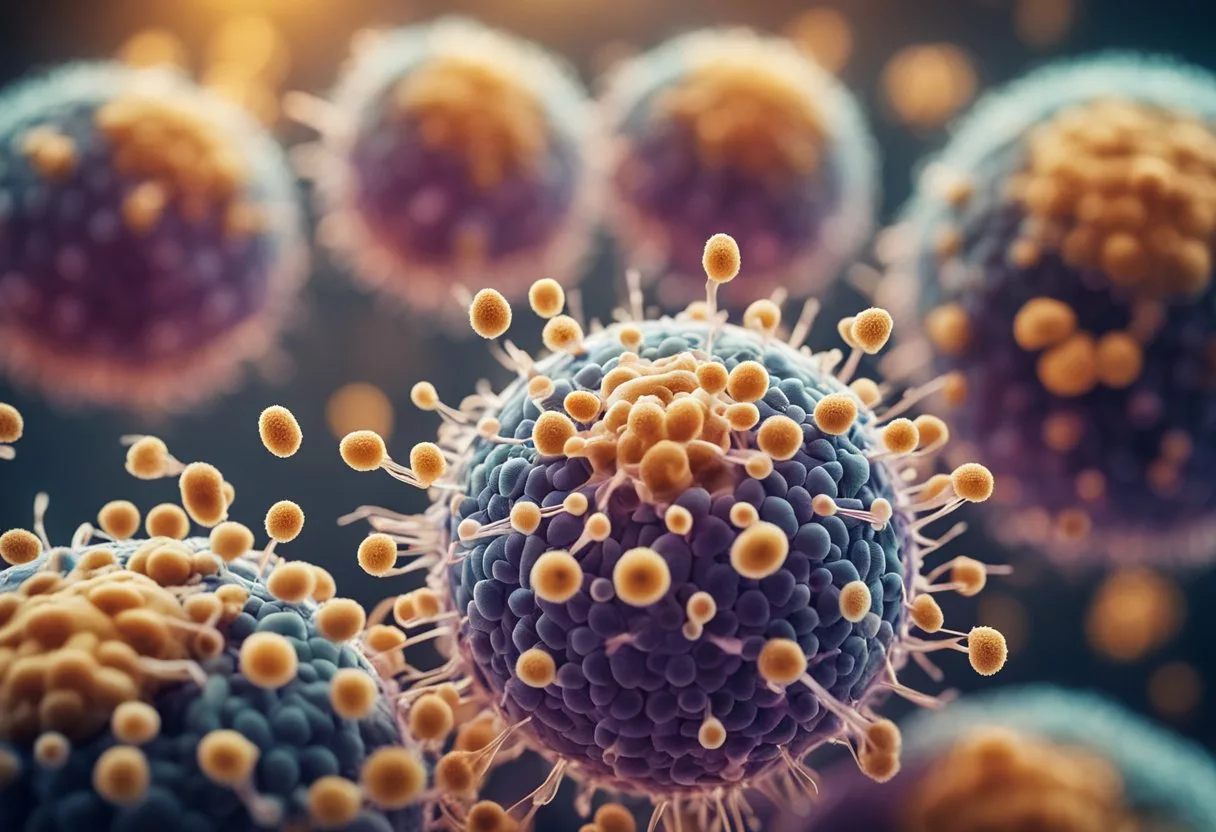Chlamydia is a common sexually transmitted infection caused by the bacterium Chlamydia trachomatis. This infection often goes unnoticed because many individuals show no symptoms. When symptoms do appear, they might include pain during urination and unusual discharge, making early detection crucial.

If left untreated, chlamydia can lead to serious health problems, such as infertility and ectopic pregnancy. It can also cause inflammation of the epididymis in men, resulting in fever and scrotal pain. The infection is easily treated with antibiotics, but prompt medical attention is essential to avoid complications.
Public health efforts focus on prevention and increased access to STI resources. These efforts aim to reduce transmission rates, especially in communities with limited healthcare access. Learn about the symptoms, treatments, and prevention strategies to protect yourself and others.
Key Takeaways
- Chlamydia is a common STI caused by Chlamydia trachomatis.
- Untreated chlamydia can lead to serious health issues like infertility.
- Prevention and prompt treatment are essential for reducing transmission.
Overview of Chlamydia

Chlamydia is a common sexually transmitted infection caused by the bacterium Chlamydia trachomatis. It can affect both men and women, leading to serious health issues if not treated.
Causes and Transmission
Chlamydia is a bacterial infection transmitted through sexual contact. It spreads via vaginal, anal, or oral sex with an infected partner. The bacteria can infect the cervix, urethra, rectum, and throat.
In women, the infection can cause abnormal vaginal discharge, pain during sex, and bleeding between periods. In men, it can result in discharge from the penis, burning sensation during urination, and pain or swelling in the testicles.
Chlamydia can also be passed from a pregnant woman to her baby during childbirth, leading to eye infections or pneumonia in the newborn.
Prevalence and Risk Factors
Chlamydia is one of the most reported sexually transmitted infections worldwide. It affects millions of people, particularly among sexually active young adults and teenagers.
Risk factors include having multiple sex partners, inconsistent condom use, and a history of other STIs. Sexually active women under the age of 25 are at higher risk due to the increased likelihood of cervical ectopy, where the cells that can be infected by Chlamydia trachomatis are more exposed.
Men who have sex with men also face higher risks due to the likelihood of transmission through anal sex.
Diagnosis of Chlamydia
Diagnosis involves laboratory testing. A healthcare provider may collect a swab from the cervix in women or the urethra in men. Alternatively, a urine sample may be used for testing.
These samples are analyzed to detect the presence of Chlamydia trachomatis. Accurate diagnosis is crucial to prevent complications such as pelvic inflammatory disease (PID) in women, which can lead to infertility if left untreated.
Timely and proper testing ensures that individuals diagnosed with chlamydia can receive the necessary antibiotic treatment to cure the infection and prevent further spread.
Signs and Symptoms

Chlamydia infection can present differently in men, women, and newborns. Recognizing the signs is crucial for prompt treatment and to prevent complications such as infertility and pelvic inflammatory disease.
Symptomatology in Men and Women
Men: Symptoms may include pain or burning during urination, discharge from the penis, and pain or swelling in the testicles. In some cases, men might experience epididymitis, which is an infection of the epididymis that causes pain and swelling near the testicles.
Women: Symptoms can be more varied. They often include unusual vaginal discharge, pain during sex, and bleeding between periods. Women might also experience pain in the lower abdomen, which can be a sign of pelvic inflammatory disease. This infection can spread to the fallopian tubes and lead to serious complications like ectopic pregnancy.
Specific Complications
Infertility: Both men and women risk infertility due to untreated chlamydia. In men, the infection can affect sperm quality. For women, the risk is higher if the infection spreads to the reproductive organs, causing damage to the fallopian tubes.
Pelvic Inflammatory Disease (PID): Women are at risk of PID. This condition can cause severe abdominal pain, fever, and long-term reproductive health issues.
Other Complications: Men may face issues like reactive arthritis, which causes joint pain and swelling. Both men and women have an increased risk of contracting HIV if they have an untreated chlamydia infection.
Manifestations in Newborns
Eye Infection (Conjunctivitis): Newborns can contract chlamydia during delivery, leading to eye infections. Symptoms include redness, swelling, and discharge from the eyes.
Pneumonia: Another serious complication is pneumonia, which can occur in newborns who contract chlamydia from their mothers. Symptoms of pneumonia in newborns include rapid breathing, coughing, and trouble feeding.
Serious Risks: If not treated, these conditions can lead to severe complications, including blindness and, in rare cases, death. Early detection and treatment are vital for protecting the health of the newborn.
Treatment and Management
Chlamydia is a common and treatable sexually transmitted infection. It’s typically cured with proper antibiotic therapy, but some considerations and complications can arise during treatment.
Antibiotic Therapy
Chlamydia is usually treated and cured with antibiotics. The most common medicines are doxycycline and azithromycin. Doxycycline is often preferred because studies show it’s more effective for treating urogenital and rectal chlamydial infections compared to azithromycin. A meta-analysis by the CDC supports this.
Some patients may need a single dose of azithromycin, while others might take doxycycline for about a week. It’s important to follow the prescribed course of medicine, even if symptoms disappear early on. Failure to complete the treatment can lead to complications or increased resistance to antibiotics.
Treatment Complications and Considerations
Untreated chlamydia can lead to serious health problems. For instance, it can cause pelvic inflammatory disease (PID) in women, which may result in infertility. In men, it can lead to infections in the testicles and epididymis, causing pain and swelling. Additionally, chlamydia can negatively impact sperm health, potentially reducing fertility, as noted by the Cleveland Clinic.
Pregnant women need specialized care to avoid transmitting the infection to their baby, which can cause eye infections or pneumonia in newborns. Compliance with treatment and regular follow-ups are crucial. Sometimes, chlamydia may recur, requiring further medical attention to ensure a full cure. Proper management and understanding of potential complications ensure the best outcomes.
Prevention Strategies

Preventing chlamydia involves adopting safer sex practices and getting regular screenings. Effective measures help reduce the spread and ensure early detection.
Safer Sex Practices
Using condoms consistently and correctly during sexual contact is one of the most effective ways to prevent chlamydia. Condoms act as a barrier, stopping the spread of sexual fluids that carry the infection. Both male and female condoms are effective.
Dental dams can also help in reducing the risk of transmission during oral sex. Limiting the number of sexual partners and avoiding sex with individuals who have multiple partners decreases the chances of exposure.
Another key strategy is to maintain an open dialogue with sexual partners about sexual health and STD testing. Mutual agreement on safe practices can significantly lower infection risks.
Regular Screening and Early Detection
Regular screening is essential, especially for sexually active individuals. Women under 25 and those with new or multiple sexual partners should have annual screenings. Tests usually involve a simple urine sample or a swab from the genital area.
Early detection prevents complications such as pelvic inflammatory disease and infertility. Healthcare providers can provide comprehensive testing, offering both lab tests and consultations for best practices in prevention.
Prompt treatment of detected infections is crucial. This also includes notifying sexual partners to prevent further spread of chlamydia. Regular screening thus plays a key role in controlling and reducing the incidence of chlamydia infections.
Long-Term Health Implications

Untreated chlamydia can lead to severe long-term health problems, affecting reproductive health, causing other medical complications, and increasing the risk of acquiring other STIs.
Impact on Reproductive Health
Chlamydia can significantly impact reproductive health. In women, the infection can cause pelvic inflammatory disease (PID), which affects the uterus and fallopian tubes. PID can lead to infertility and increase the risk of an ectopic pregnancy.
Men can experience painful swelling of the testicles and epididymis, known as epididymitis. This condition may reduce fertility. Both men and women are at risk of permanent reproductive damage if chlamydia remains untreated.
Other Health Complications
Beyond reproductive health, untreated chlamydia can cause other serious health issues. It is one of the leading causes of trachoma, an eye infection that can result in blindness.
In some cases, chlamydia may lead to reactive arthritis, causing joint pain and swelling. The infection can also spread to other parts of the body, leading to complications such as pneumonia in newborns if the mother is infected during childbirth.
Association With Other STIs
Chlamydia increases the risk of contracting other sexually transmitted infections (STIs), including gonorrhea, syphilis, and HIV. When chlamydia co-occurs with other STIs, the complications may become more severe.
This risk is heightened if both sex partners are untreated, as one partner can continually reinfect the other. Treatment and prevention strategies should be followed to reduce this risk and protect overall health.
Public Health Considerations
Addressing chlamydia infection from a public health perspective involves education, surveillance programs, and policy-making. These efforts aim to reduce the prevalence and impact of this sexually transmitted disease.
Educational Initiatives
Educating the public about chlamydia is key to prevention. Comprehensive sex education programs can inform people about how chlamydia is transmitted. This includes discussing the importance of condom use and regular testing. Schools, clinics, and community centers play a vital role in providing accurate information.
Public health campaigns can further raise awareness. Social media and public service announcements can reach a wide audience. These campaigns can stress the importance of early diagnosis and treatment. Educational materials must be easy to understand and accessible to people of all backgrounds.
Chlamydia Surveillance Programs
Effective surveillance programs are essential for tracking chlamydia infection rates. These programs collect data from healthcare providers and laboratories. This data helps identify trends and outbreaks in different regions. By monitoring these trends, public health officials can target interventions where needed most.
Surveillance also aids in evaluating the effectiveness of existing programs. If infection rates are not decreasing, changes can be made. Coordination between local, state, and national health departments ensures comprehensive coverage. Consistent and accurate data collection is crucial.
Policy and Resource Allocation
Policymaking is crucial for addressing chlamydia at a public health level. Governments must allocate resources to support education and surveillance programs. This includes funding for testing and treatment services. Policies should also support mandatory reporting of chlamydia cases. This helps maintain accurate data and coordinate responses.
Investing in healthcare infrastructure is another critical aspect. Clinics need the resources to offer affordable and accessible screening. Policies should also promote sexual health services in underserved areas. Effective allocation of resources can greatly reduce the public health burden of chlamydia.
Frequently Asked Questions
Chlamydia is a common sexually transmitted infection (STI) that can cause serious health issues if untreated. Below are answers to common questions about chlamydia.
What are the common symptoms of chlamydia in men and women?
Chlamydia symptoms can vary. In women, it can cause painful urination, vaginal discharge, and pain during sex. Men may experience discharge from the penis, testicular pain, and painful urination.
How is chlamydia transmitted between individuals?
Chlamydia is primarily spread through sexual contact, including vaginal, anal, and oral sex. It can also be transmitted from a pregnant woman to her baby during childbirth.
Can chlamydia be completely cured with treatment?
Yes, chlamydia is easily treated and cured with antibiotics. It is important to complete the entire course of medication to ensure the infection is fully cleared.
What are the potential complications if chlamydia is left untreated?
Untreated chlamydia can lead to serious health problems. In women, it may cause pelvic inflammatory disease (PID), ectopic pregnancy, and infertility. Men can experience epididymitis, which can also affect fertility.
How long can the symptoms of chlamydia remain unnoticed?
Chlamydia is often called a “silent” infection because many people do not have symptoms. Symptoms, if they do appear, can take several weeks after exposure.
Are there natural remedies effective against chlamydia infection?
Natural remedies are not effective against chlamydia. The only reliable treatment is antibiotics prescribed by a healthcare provider. Seeking professional medical advice is crucial for proper treatment.